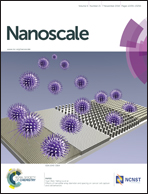Structural evolution of NiAu nanoparticles under ambient conditions directly revealed by atom-resolved imaging combined with DFT simulation†
Abstract
From an economic point of view, the structural stability of noble-transition bimetallic catalysts is as significant as their well-studied catalytic efficiency. The structural evolution and corresponding dynamics of NiAu bimetallic nanoparticles under ambient conditions are investigated using in situ Cs-corrected STEM and DFT calculations. During oxidization, the Au component promotes dissociation of oxygen and initiates Ni oxidization, which simultaneously drives the migration of Au atoms, thus yielding multi-shell structures (denoted by Ni@Au@NiO). The subsequent hydrogen reduction induces surface reconstruction, forming fcc-NiAu clusters. After several cycles of catalyzing CO oxidization, both inverse Au segregation and Ni recrystallization occur, which are ascribed to exothermic excitation. The results of this study can help researchers understand the evolutionary behaviors of the bimetallic nanoparticles under ambient conditions as well as optimize the structural design of bimetallic catalysts.


 Please wait while we load your content...
Please wait while we load your content...